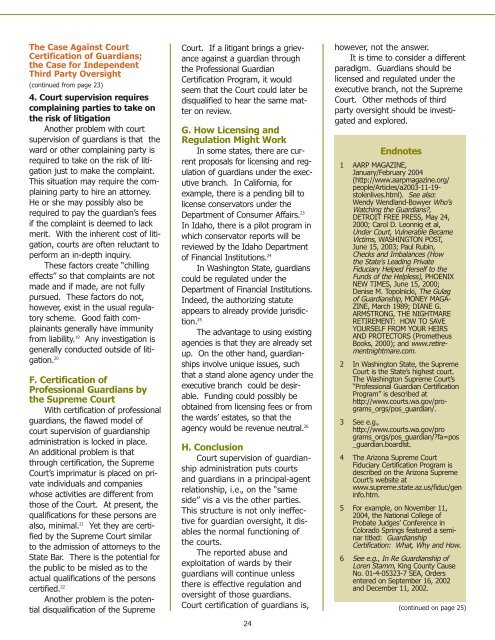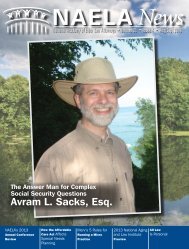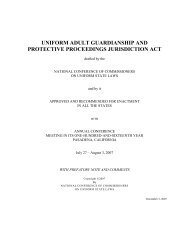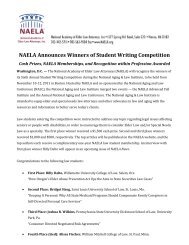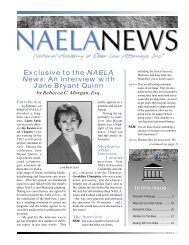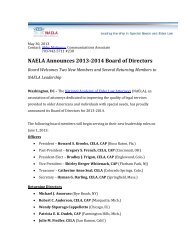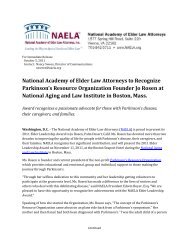N A E L A - National Academy of Elder Law Attorneys
N A E L A - National Academy of Elder Law Attorneys
N A E L A - National Academy of Elder Law Attorneys
You also want an ePaper? Increase the reach of your titles
YUMPU automatically turns print PDFs into web optimized ePapers that Google loves.
The Case Against Court<br />
Certification <strong>of</strong> Guardians;<br />
the Case for Independent<br />
Third Party Oversight<br />
(continued from page 23)<br />
4. Court supervision requires<br />
complaining parties to take on<br />
the risk <strong>of</strong> litigation<br />
Another problem with court<br />
supervision <strong>of</strong> guardians is that the<br />
ward or other complaining party is<br />
required to take on the risk <strong>of</strong> litigation<br />
just to make the complaint.<br />
This situation may require the complaining<br />
party to hire an attorney.<br />
He or she may possibly also be<br />
required to pay the guardian’s fees<br />
if the complaint is deemed to lack<br />
merit. With the inherent cost <strong>of</strong> litigation,<br />
courts are <strong>of</strong>ten reluctant to<br />
perform an in-depth inquiry.<br />
These factors create “chilling<br />
effects” so that complaints are not<br />
made and if made, are not fully<br />
pursued. These factors do not,<br />
however, exist in the usual regulatory<br />
scheme. Good faith complainants<br />
generally have immunity<br />
from liability. 19 Any investigation is<br />
generally conducted outside <strong>of</strong> litigation.<br />
20<br />
F. Certification <strong>of</strong><br />
Pr<strong>of</strong>essional Guardians by<br />
the Supreme Court<br />
With certification <strong>of</strong> pr<strong>of</strong>essional<br />
guardians, the flawed model <strong>of</strong><br />
court supervision <strong>of</strong> guardianship<br />
administration is locked in place.<br />
An additional problem is that<br />
through certification, the Supreme<br />
Court’s imprimatur is placed on private<br />
individuals and companies<br />
whose activities are different from<br />
those <strong>of</strong> the Court. At present, the<br />
qualifications for these persons are<br />
also, minimal. 21 Yet they are certified<br />
by the Supreme Court similar<br />
to the admission <strong>of</strong> attorneys to the<br />
State Bar. There is the potential for<br />
the public to be misled as to the<br />
actual qualifications <strong>of</strong> the persons<br />
certified. 22<br />
Another problem is the potential<br />
disqualification <strong>of</strong> the Supreme<br />
Court. If a litigant brings a grievance<br />
against a guardian through<br />
the Pr<strong>of</strong>essional Guardian<br />
Certification Program, it would<br />
seem that the Court could later be<br />
disqualified to hear the same matter<br />
on review.<br />
G. How Licensing and<br />
Regulation Might Work<br />
In some states, there are current<br />
proposals for licensing and regulation<br />
<strong>of</strong> guardians under the executive<br />
branch. In California, for<br />
example, there is a pending bill to<br />
license conservators under the<br />
Department <strong>of</strong> Consumer Affairs. 23<br />
In Idaho, there is a pilot program in<br />
which conservator reports will be<br />
reviewed by the Idaho Department<br />
<strong>of</strong> Financial Institutions. 24<br />
In Washington State, guardians<br />
could be regulated under the<br />
Department <strong>of</strong> Financial Institutions.<br />
Indeed, the authorizing statute<br />
appears to already provide jurisdiction.<br />
25<br />
The advantage to using existing<br />
agencies is that they are already set<br />
up. On the other hand, guardianships<br />
involve unique issues, such<br />
that a stand alone agency under the<br />
executive branch could be desirable.<br />
Funding could possibly be<br />
obtained from licensing fees or from<br />
the wards’ estates, so that the<br />
agency would be revenue neutral. 26<br />
H. Conclusion<br />
Court supervision <strong>of</strong> guardianship<br />
administration puts courts<br />
and guardians in a principal-agent<br />
relationship, i.e., on the “same<br />
side” vis a vis the other parties.<br />
This structure is not only ineffective<br />
for guardian oversight, it disables<br />
the normal functioning <strong>of</strong><br />
the courts.<br />
The reported abuse and<br />
exploitation <strong>of</strong> wards by their<br />
guardians will continue unless<br />
there is effective regulation and<br />
oversight <strong>of</strong> those guardians.<br />
Court certification <strong>of</strong> guardians is,<br />
24<br />
however, not the answer.<br />
It is time to consider a different<br />
paradigm. Guardians should be<br />
licensed and regulated under the<br />
executive branch, not the Supreme<br />
Court. Other methods <strong>of</strong> third<br />
party oversight should be investigated<br />
and explored.<br />
Endnotes<br />
1 AARP MAGAZINE,<br />
January/February 2004<br />
(http://www.aarpmagazine.org/<br />
people/Articles/a2003-11-19-<br />
stolenlives.html). See also:<br />
Wendy Wendland-Bowyer Who’s<br />
Watching the Guardians?,<br />
DETROIT FREE PRESS, May 24,<br />
2000; Carol D. Leonnig et al,<br />
Under Court, Vulnerable Became<br />
Victims, WASHINGTON POST,<br />
June 15, 2003; Paul Rubin,<br />
Checks and Imbalances (How<br />
the State’s Leading Private<br />
Fiduciary Helped Herself to the<br />
Funds <strong>of</strong> the Helpless), PHOENIX<br />
NEW TIMES, June 15, 2000;<br />
Denise M. Topolnicki, The Gulag<br />
<strong>of</strong> Guardianship, MONEY MAGA-<br />
ZINE, March 1989; DIANE G.<br />
ARMSTRONG, THE NIGHTMARE<br />
RETIREMENT: HOW TO SAVE<br />
YOURSELF FROM YOUR HEIRS<br />
AND PROTECTORS (Prometheus<br />
Books, 2000); and www.retirementnightmare.com.<br />
2 In Washington State, the Supreme<br />
Court is the State’s highest court.<br />
The Washington Supreme Court’s<br />
“Pr<strong>of</strong>essional Guardian Certification<br />
Program” is described at<br />
http://www.courts.wa.gov/programs_orgs/pos_guardian/.<br />
3 See e.g.,<br />
http://www.courts.wa.gov/pro<br />
grams_orgs/pos_guardian/?fa=pos<br />
_guardian.boardlst.<br />
4 The Arizona Supreme Court<br />
Fiduciary Certification Program is<br />
described on the Arizona Supreme<br />
Court’s website at<br />
www.supreme.state.az.us/fiduc/gen<br />
info.htm.<br />
5 For example, on November 11,<br />
2004, the <strong>National</strong> College <strong>of</strong><br />
Probate Judges’ Conference in<br />
Colorado Springs featured a seminar<br />
titled: Guardianship<br />
Certification: What, Why and How.<br />
6 See e.g., In Re Guardianship <strong>of</strong><br />
Loren Stamm, King County Cause<br />
No. 01-4-05323-7 SEA, Orders<br />
entered on September 16, 2002<br />
and December 11, 2002.<br />
(continued on page 25)


